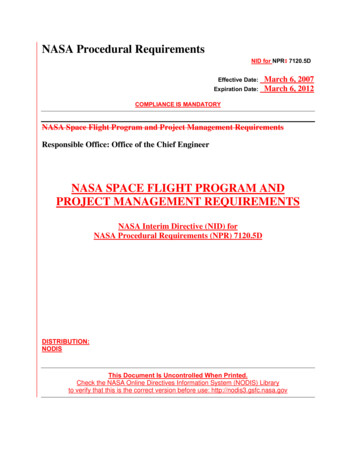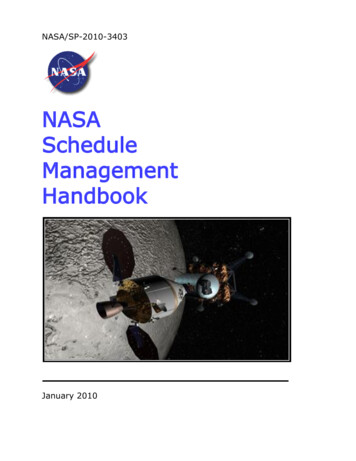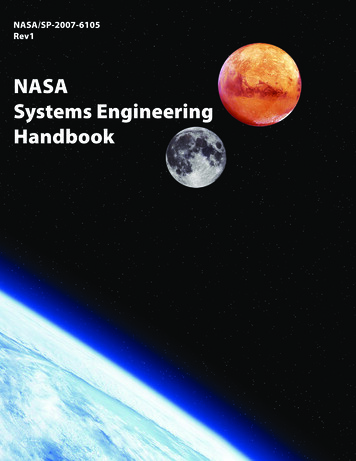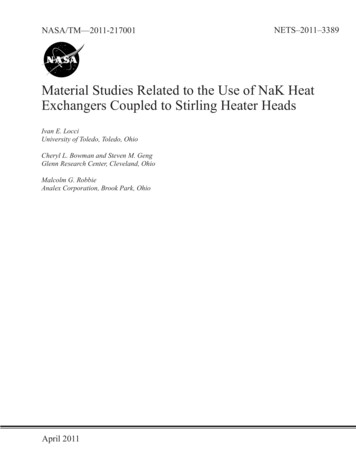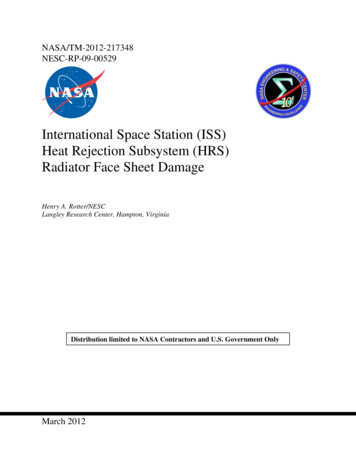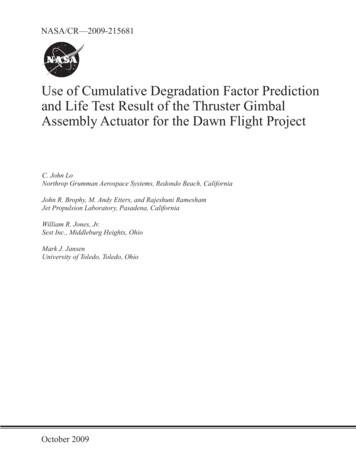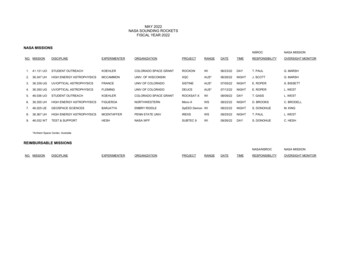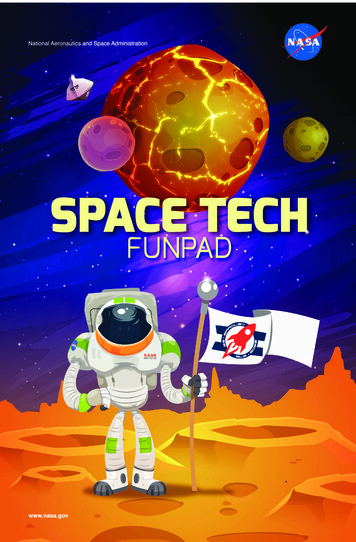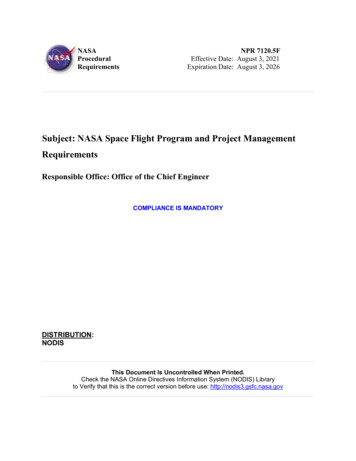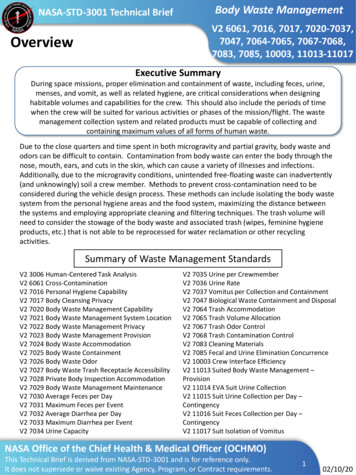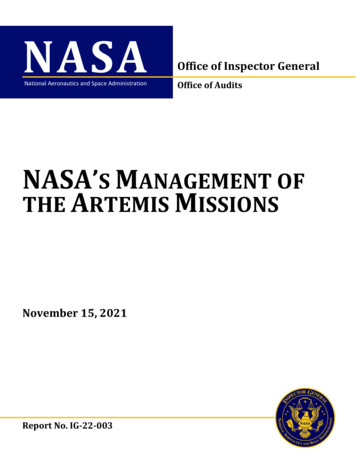
Transcription
NASANational Aeronautics and Space AdministrationOffice of Inspector GeneralOffice of AuditsNASA’S MANAGEMENT OFTHE ARTEMIS MISSIONSNovember 15, 2021Report No. IG-22-003
Office of Inspector GeneralTo report, fraud, waste, abuse, or mismanagement, contact the NASA OIG Hotline at 800-424-9183 or 800-535-8134 (TDD) orvisit https://oig.nasa.gov/hotline.html. You can also write to NASA Inspector General, P.O. Box 23089, L’Enfant Plaza Station,Washington, D.C. 20026. The identity of each writer and caller can be kept confidential, upon request, to the extent permittedby law.To suggest ideas or request future audits, contact the Assistant Inspector General for Audits at https://oig.nasa.gov/aboutAll.html.
RESULTS IN BRIEFNASA’s Management of the Artemis MissionsNASA Office of Inspector GeneralOffice of AuditsNovember 15, 2021IG-22-003 (A-20-008-01)WHY WE PERFORMED THIS AUDITThe Artemis program seeks to return humans to the Moon by late 2024 rather than 2028 as initially planned. Faced witha shortened timeframe, an uncertain budget, and the nascency of the required development work, NASA implementedmodifications to its routine procurement and program management practices in an attempt to accelerate the missionschedule and reduce costs. The Agency’s lunar strategy includes development of the Space Launch System (SLS) heavylift rocket, the Orion Multi-Purpose Crew Vehicle (Orion) capsule, a Human Landing System (HLS) to transport astronautsfrom lunar orbit to the Moon’s surface, the Gateway outpost orbiting the Moon, next-generation spacesuits, anddelivery of science investigations and technology demonstrations to the lunar surface by commercial landers.Currently NASA’s most ambitious and costly activity, the Artemis program faces schedule, procurement, technical, andfunding risks. This includes procurement of Artemis-related technologies and space flight hardware using research anddevelopment contracts that leverage commercial capabilities but require a Federal Acquisition Regulation (FAR)deviation for acquiring services and hardware. SLS and Orion have also experienced technical challenges in laterdevelopment phases as well as the effects of COVID-19 restrictions and severe weather events. Additionally,the Gateway and HLS Programs received significantly less funding in fiscal year (FY) 2021 than required to meet NASA’sinitial acquisition strategy.As the second in a series of audits examining NASA’s Artemis plans, this report assessed the Artemis program’s scheduleand projected costs as well as how the Agency’s acquisition and programmatic approaches facilitate landing astronautson the Moon. To complete this work, we reviewed documents, systems, policies, and procedures pertaining toschedule, cost, budget, operations, acquisition strategy, and program/project management requirements related toArtemis, its programs, and contactors. We also reviewed contracts, interviewed NASA and contractor officials, andconducted site visits at SpaceX headquarters in California and its Starbase facility in Texas.WHAT WE FOUNDNASA’s three initial Artemis missions, designed to culminate in a crewed lunar landing, face varying degrees of technicaldifficulties and delays heightened by the COVID-19 pandemic and weather events that will push launch schedules frommonths to years past the Agency’s current goals. With Artemis I mission elements now being integrated and tested atKennedy Space Center, we estimate NASA will be ready to launch by summer 2022 rather than November 2021 asplanned. Although Artemis II is scheduled to launch in late 2023, we project that it will be delayed until at leastmid-2024 due to the mission’s reuse of Orion components from Artemis I. While the Advanced Exploration Systems(AES) Division—which includes HLS, Gateway, and next-generation spacesuits—is working on an integrated masterschedule (IMS) for Artemis III that incorporates Exploration Systems Development (ESD) Division programs—SLS, Orion,and Exploration Ground Systems—the draft version does not include information on programs critical to Artemis thatare outside of AES and ESD. Given the time needed to develop and fully test the HLS and new spacesuits, we projectNASA will exceed its current timetable for landing humans on the Moon in late 2024 by several years.
In addition, NASA lacks a comprehensive and accurate cost estimate that accounts for all Artemis program costs. ForFYs 2021 through 2025, the Agency uses a rough estimate for the first three missions that excludes 25 billion for keyactivities related to planned missions beyond Artemis III. When aggregating all relevant costs across mission directorates,NASA is projected to spend 93 billion on the Artemis effort up to FY 2025. We also project the current production andoperations cost of a single SLS/Orion system at 4.1 billion per launch for Artemis I through IV, although the Agency’songoing initiatives aimed at increasing affordability seek to reduce that cost. Multiple factors contribute to the high costof ESD programs, including the use of sole-source, cost-plus contracts; the inability to definitize key contract terms in atimely manner; and the fact that except for the Orion capsule, its subsystems, and the supporting launch facilities, allcomponents are expendable and “single use” unlike emerging commercial space flight systems. Without capturing,accurately reporting, and reducing the cost of future SLS/Orion missions, the Agency will face significant challenges tosustaining its Artemis program in its current configuration.Further, for HLS, NASA has modified its traditional acquisition approach for large space flight programs to reduce costs,encourage innovation, and meet an aggressive schedule for its Artemis lunar landings. While its acquisition approachrelies on competition to drive down costs and ensure redundancy, the Agency selected a single provider—SpaceX—after receiving 2.5 billion less than requested for HLS development in FY 2021. To help compensate, the Agency isaccelerating its Lunar Exploration Transportation Services procurement for sustainable, regularly-recurring crewedlunar transportation services, and in September 2021 awarded five HLS contracts for the continued development ofsustainable HLS capabilities as a prelude to the competitive services procurement. Over the past year, NASA hasworked to solidify its HLS requirements and standards, established insight and collaboration teams, and plans toestablish resident offices at SpaceX. However, under NASA’s tailored project management approach, HLS will use lessstandardized milestone reviews and instead utilize other techniques such as annual synchronization reviews throughoutdevelopment and testing, but this approach runs the risk of technical changes later in development. Finally, instead ofusing a systems integrator or Artemis program manager, NASA is establishing various collaborative processes includingnew boards and a multi-directorate council to facilitate the communication and approval process. The effectiveness ofthis approach remains to be seen. While these modified approaches have the potential benefit of decreasing costs andencouraging innovation, they also raise the possibility of schedule and performance risks on NASA’s human-rated systems.WHAT WE RECOMMENDEDTo increase accuracy, transparency, and safety of human space flight, we recommended NASA’s Associate Administratorfor Exploration Systems Development Mission Directorate: (1) develop a realistic, risk-informed schedule that includessufficient margin to better align Agency expectations with the development schedule; (2) expand upon the existing draftArtemis IMS to include Artemis programs outside AES and ESD to properly align dependencies across directorates;(3) develop an Artemis-wide cost estimate and update it on an annual basis; (4) maintain an accounting of per-missioncosts and establish a benchmark against which NASA can assess the outcome of initiatives to increase the affordability ofESD systems; (5) definitize outstanding Artemis-related contracts within 180 days in accordance with NASA FARSupplement 1843.7005(a); (6) develop a realistic funding profile and schedule given the underfunding of HLS in FY 2021,selection of one HLS award, and desire to compete a sustainability contract for future lunar missions; and (7) identifymeasurable cost reduction targets for its ESD contractors. We also recommended NASA’s Chief Engineer in coordinationwith the HLS Program Manager: (8) validate annual synchronization reviews meet the intent and expectations of themilestone reviews replaced by the tailored acquisition approach, and the NASA Deputy Administrator in coordinationwith Mission Directorate Associate Administrators: (9) codify the remaining governance structure such as the FederatedBoards and Joint Directorate Program Management Council.We provided a draft of this report to NASA management who concurred withRecommendations 1, 5, 6, 7, and 8, and described planned actions to addressthem. We consider the proposed actions responsive for theserecommendations and will close them upon completion and verification. Inaddition, the Agency partially concurred with Recommendations 2 and 9 andnon-concurred with Recommendations 3 and 4. These four recommendationswill remain unresolved pending further discussions with NASA.For more information on the NASAOffice of Inspector General and toview this and other reports visithttps://oig.nasa.gov/.
TABLE OF CONTENTSIntroduction. 1Background . 2Artemis Program Making Progress But Timetable Slipping By Months for Test Flights and Yearsfor Lunar Landing. 12Artemis I Progressing Toward Launch by Summer 2022 . 12Artemis II Delayed Until at Least Mid-2024 Due to Artemis I Dependencies and Reuse ofOrion Avionics . 13Time Needed for Development, Testing, and Certification of the HLS and Spacesuits Will DelayPlanned Lunar Landing Schedule by Several Years . 14NASA’s Estimates Significantly Understate Costs of Artemis Program . 19NASA Lacks a Credible Cost Estimate for the Artemis Missions . 19Total Artemis Costs Expected to Reach 93 Billion by 2025. 21SLS/Orion Production and Operating Costs Will Average Over 4 Billion Per Launch . 23Ongoing Affordability Initiatives and Commercial Alternatives . 25NASA’s Modified Acquisition and Management Approaches for HLS Will Reduce Costs andEncourage Innovation But Also Increase Risk . 28Only One Company Selected for HLS Demonstration Mission Due to Reduced Funding . 28Modified Fixed-Price Contract Will Reduce Cost Growth and NASA’s Process to MitigateTechnical and Safety Risks Is Being Implemented . 30Project Management Approach for the Human Landing System Modeled After CommercialCrew Program . 32NASA Managing Artemis Activities Using Newly Established Processes Rather Than a SystemsIntegrator or Program Manager . 33Conclusion . 36Recommendations, Management’s Response, and Our Evaluation . 37Appendix A: Scope and Methodology . 39Appendix B: HLS Program’s Tailored Project Management Approach. 42Appendix C: Artemis System Descriptions . 44Appendix D: Artemis Contracts. 57Appendix E: Management’s Comments . 61Appendix F: Report Distribution . 67NASA Office of Inspector GeneralIG-22-003 i
STRLVIPERxEMUxEVAAgency Baseline CommitmentAdvanced Exploration SystemsCommercial Lunar Payload ServicesCoronavirus Disease 2019Exploration Ground SystemsEuropean Space AgencyExploration Systems DevelopmentExtravehicular ActivityFederal Acquisition Regulationfiscal yearGovernment Accountability OfficeHabitation and Logistics OutpostHuman Exploration and Operations Mission DirectorateHuman Landing Systemintegrated master scheduleInternational Space StationJoint Cost and Schedule Confidence LevelKey Decision PointLunar Exploration Transportation ServicesNext Space Technologies for Exploration PartnershipsNASA FAR SupplementOffice of Inspector GeneralPower and Propulsion ElementSystems Engineering and IntegrationSchedule Risk AnalysisSpace Launch SystemTechnology Readiness LevelVolatiles Investigating Polar Exploration RoverExploration Extravehicular Mobility UnitExploration Extravehicular ActivityNASA Office of Inspector GeneralIG-22-003 ii
INTRODUCTIONIn March 2019, NASA committed to landing humans on the Moon’s South Pole by 2024 instead of 2028as initially planned.1 Faced with a shortened timeframe, an uncertain budget, and the nascency of therequired development work, NASA implemented modifications to its routine procurement and programmanagement practices in an effort to reduce costs and accelerate the mission schedule. In addition tothe Space Launch System (SLS) heavy-lift rocket, the Orion Multi-Purpose Crew Vehicle (Orion) capsule,and a Human Landing System (HLS), the Agency’s lunar strategy includes development of both theGateway outpost orbiting the Moon and next-generation spacesuits capable of sustaining astronauts onthe lunar surface, as well as multiple deliveries of science investigations and technology demonstrationsto the Moon by commercial landers.This ambitious schedule is not without risk. NASA is procuring Artemis-related technologies and spaceflight hardware using a variety of methods, including research and development contracts that leveragecommercial capabilities and state-of-the-art innovation, but require a Federal Acquisition Regulation(FAR) deviation. Additionally, and not unexpectedly, Orion and SLS have experienced technicalchallenges in later development phases, along with enduring the effects of Coronavirus Disease 2019(COVID-19) restrictions for over 18 months and numerous severe weather events. For example, duringtesting, Orion had an internal power and data unit that lost redundancy in November 2020, and the SLSrequired a second hot fire test of its Core Stage in March 2021 adding months to an already delayedschedule, making the planned November 2021 Artemis I launch date not feasible.2In addition to the procurement and technical risks, both the Gateway and HLS Programs receivedsignificantly less funding for fiscal year (FY) 2021 than initially required. Costs for the Artemis mission,spread among various NASA directorates and divisions, are expected to reach 93 billion by FY 2025.3Although the Biden Administration has indicated it will continue the Artemis program, the funding levelis still being determined and the Administration’s commitment to the current goal of landing astronautson the Moon in 2024 is in flux with a revised timetable expected in late 2021.This report is the second in a series of audits examining NASA’s Artemis plans. In this review, weassessed the Artemis program’s schedule and projected costs, as well as how the Agency’s acquisitionand programmatic approaches seek to facilitate landing astronauts on the Moon. See Appendix A fordetails on the audit’s scope and methodology.1In a recent report on NASA’s development of next-generation spacesuits, we concluded that delays in the Agency’s effortswill preclude a lunar landing in late 2024. NASA Office of Inspector General (OIG), NASA's Development of Next-GenerationSpacesuits (IG-21-025, August 10, 2021).2In October 2021, the Agency announced that the Artemis I launch would be delayed until February 2022 at the earliest.NASA officials said they plan to announce an official target launch date after several key tests are completed in the comingmonths. In November 2021, the NASA Administrator announced additional delays with Artemis II launching no later thanMay 2024 and Artemis III launching no earlier than 2025.3The 93 billion figure was derived from examining NASA’s obligations, FY 2021 Budget Operating Plan, and budgetprojections for programs and projects involved in the Artemis program between FY 2012 and FY 2025.NASA Office of Inspector GeneralIG-22-003 1
BackgroundScheduled to launch in late 2021, Artemis I is planned as the first uncrewed flight of the integratedSLS/Orion system on a trajectory that will include a series of orbits around the Moon. The secondmission and first crewed flight—Artemis II—will also orbit the Moon and prepare the way for Artemis IIIin late 2024. In this third mission, the Orion capsule will dock in lunar orbit directly to the HLS totransport astronauts to and from the lunar surface.4 Prior to the astronauts’ arrival, NASA intends toexplore the lunar landing area with robotic systems as part of its Commercial Lunar Payload Services(CLPS) initiative.5 Subsequent Artemis missions will include a longer-term presence on the Moon thatincorporates use of the Gateway in lunar orbit, ground infrastructure on the lunar surface such as ahabitat, and surface transportation like a lunar rover. NASA’s plan to land astronauts on the Moon reliesheavily on the maturity of a number of key systems, including the SLS/Orion and next-generationspacesuits. In addition, NASA will rely on the commercial sector to launch both the Gateway and HLSinto Near Rectilinear Halo Orbit.6 Figure 1 shows the current schedule for the Artemis explorationmissions and commercial launches in support of a lunar landing.4NASA’s goal is to have the Gateway in an orbit around the Moon to support Artemis IV. The initial elements of the orbitinglunar platform will consist of the Power and Propulsion Element, which provides electrical power and propulsion to theGateway, and the Habitation and Logistics Outpost, which provides working and living space for the astronauts while theOrion is docked to it.5Initiated in 2018, NASA’s CLPS initiative is intended to allow rapid acquisition of lunar delivery services from Americancompanies for payloads that advance science, exploration, and commercial development of the Moon.6Near Rectilinear Halo Orbit is an orbit around the Moon with a 7-day cycle, which will take the Gateway, Orion, and HLS asclose to the lunar surface as 1,600 kilometers (1,000 miles) and as far away as 68,260 kilometers (42,415 miles). Consequently,the lunar lander can efficiently depart the Gateway to travel to the lunar surface approximately every 7 days.NASA Office of Inspector GeneralIG-22-003 2
Figure 1: Calendar Year Timeline of NASA Artemis and Related Commercial Launches (as of September 2021)Source: NASA Office of Inspector General (OIG) depiction of Agency program information.Artemis Concept for Returning Astronauts to the MoonBy the time Artemis III launches, NASA expects to have flown the SLS/Orion system twice with oneuncrewed mission (Artemis I) and a second crewed mission (Artemis II) around the Moon with afunctioning Environmental Control and Life Support System. During the Artemis II mission, Orion willremain in Earth’s orbit for several days to ensure the life support system is fully operational beforeproceeding to the orbit around the Moon. All three missions will send the spacecraft into a trans-lunarinjection that places the Orion capsule and its service module in a trajectory toward the Moon.7 OnArtemis III, the Orion spacecraft will then use the propulsion produced by its service module to travelto Near Rectilinear Halo Orbit around the Moon. NASA also plans to position the Gateway in this orbitto act as an outpost for staging Moon landings and future deep space or Mars departures.NASA considers Artemis III a demonstration mission that will illustrate the capability to land a crewedspacecraft on the Moon. NASA has contracted with Space Exploration Technologies Corp. (SpaceX) todevelop an HLS vehicle to transport two astronauts to the Moon’s South Pole on this mission.Compared to the first two missions, the Artemis III mission profile is much more complicated in that it7A trans-lunar injection is a propulsive maneuver used to set a spacecraft on a trajectory that will cause it to arrive atthe Moon.NASA Office of Inspector GeneralIG-22-003 3
will require a number of launches of Tanker Starships and a fuel depot to provide propellent for the HLSand will also involve flying the SLS/Orion separately to link up the astronauts with the HLS in lunar orbit.Figure 2 presents a graphical summary of the Artemis III mission.Figure 2: Planned Artemis III Mission Profile (as of October 2021)Source: NASA OIG presentation of Agency data.NASA Office of Inspector GeneralIG-22-003 4
SpaceX will use a Super Heavy rocket boostercurrently in development to launch the HLS Starshipfrom Kennedy Space Center (Kennedy) and SpaceX’slaunch facility in Boca Chica, Texas, into the Earth’sorbit where it will dock with SpaceX’s depotspacecraft for refueling.8 From there, the Starshipwill use its internal propulsion to travel to NearRectilinear Halo Orbit where it will position in lunarorbit to dock directly with the Orion capsule. NASAplans to separately launch and fly four astronauts inthe Orion to dock directly with the pre-positionedHLS Starship. Two astronauts will board the HLS anddescend to the Moon’s surface while the otherastronauts remain on the Orion to provide support and communication for the landing team. While onthe surface for up to a week, the astronauts will leave the spacecraft and conduct one or more lunarexcursions. Upon completion, the HLS will launch from the Moon and return to the Orion in lunar orbitbefore Orion heads back to Earth with the four astronauts for a landing in the Pacific Ocean. Followingthis demonstration of the HLS, NASA intends to return crew to the lunar surface by using a FAR-basedcontract, Lunar Exploration Transportation Services (LETS), in which commercial companies will developsustainable human landing systems and provide recurring crewed lunar landing services. Follow onmissions will use additional capabilities including the Gateway and lunar rovers, with longer durationstays on the lunar surface. See Appendix B for information on HLS’s programmatic approach.NASA’s Organizational and Programmatic Structure forIntegrating Space Flight ElementsArtemis is not a formal program under NASA management standards despite spanning multiple missiondirectorates, divisions, and programs.9 Unlike the Apollo or Shuttle Programs that consolidated allefforts under a single programmatic organization, NASA decided to establish a more distributed methodfor integrating Artemis elements and capabilities. As part of this process, the Agency first designatedlead directorates or divisions to integrate the missions. Overall, the Human Exploration and OperationsMission Directorate (HEOMD) is responsible for integrating the Artemis missions.10 For Artemis I and II,NASA’s Exploration Systems Development (ESD) Division, which includes the SLS, Orion, and Exploration8Although not fully planned yet for Artemis flights, future missions are expected to launch from a floating launch pad in theGulf of Mexico, which could add additional launch facilities and potentially ease safety and regulatory concerns withlaunching a massive rocket near populated areas.9NASA Procedural Requirements 7120.5E, NASA Space Flight Program and Project Management Requirements (Updatedw/Change 18) (August 14, 2012). A program is defined as a strategic investment by a Mission Directorate or Mission SupportOffice that has a defined architecture and/or technical approach, requirements, funding level, and management structurethat initiates and directs one or more projects. A program implements a strategic direction that NASA has identified asneeded to accomplish Agency goals and objectives.10On September 21, 2021, the NASA Administrator announced that the Agency would be splitting HEOMD into two separatemission directorates. The Exploration Systems Development Mission Directorate is responsible for integrating the earlyArtemis missions, defining and managing systems development for programs critical to NASA’s Artemis program, andplanning for NASA’s Moon to Mars exploration approach in an integrated manner. The other space flight missiondirectorate—Space Operations Mission Directorate—will focus on launch and space operations, including the InternationalSpace Station, commercialization of low Earth orbit, and eventually operations around the Moon. The implementationprocess for this organizational change will take several months. For purposes of this report, we refer to the organizationusing its pre-transition terminology.NASA Office of Inspector GeneralIG-22-003 5
Ground Systems (EGS) Programs, is the lead authority for integration. The Advanced ExplorationSystems (AES) Division is responsible for NASA's return of humans to the Moon; associated lunarprograms such as Gateway, HLS, Lunar Terrain Vehicle, and next-generation spacesuits; and overallmission integration starting with Artemis III. NASA’s Science and Space Technology Mission Directoratesalso contribute vital aspects to the Artemis missions such as technology demonstrations and roboticexplorations of the Moon prior to astronaut landings. See Appendix C for a description of key Artemissystems such as the SLS and HLS and related science missions.In order to ensure strategic alignment across the Agency, in October 2019 the NASA Administratorannounced the formation of a Federated Board for Artemis missions led by the deputy associateadministrators of HEOMD and the Science and Space Technology Mission Directorates (see Figure 3).The Board was charged with cross-directorate coordination and implementation of Agency strategicguidance; out-year planning integration, including future architecture definition and planning; andlong-term strategic assessments to inform NASA’s strategy. The Board meets weekly and focusesspecifically on technical development and integration of a long-term lunar surface presence as well asthe first human mission to Mars. Additionally, an “expanded” Federated Board was created thatincludes other NASA stakeholders, such as the Offices of General Counsel and International andInteragency Relations, and also meets weekly.NASA Office of Inspector GeneralIG-22-003 6
Figure 3: Artemis Program Organizational Structure and Integration (as of August 2021)Source: NASA OIG presentation of Agency information.In September 2020, HEOMD was reorganized to include a Systems Engineering and Integration (SE&I)function at the mission directorate level responsible for ensuring program and project requirementsreflect HEOMD’s overall strategy, leading the formulation of mission plans, and providing technicaldirection for HEOMD activities. The SE&I function can also participate in several joint control boardsthat bring together HEOMD programs for the purpose of issue resolution. AES has a similar capabilitywith its SE&I function to integrate all programs and projects operating as part of the lunar landingmissions starting with Artemis III. AES was designated the lead office to oversee different phases ofmission operations—known as “integration spheres”—and has delegated technical work and integrationto designated programs: from launch, to lunar orbit, to the lunar surface, and everything in between.AES maintains overall accountability and integration responsibility over Artemis missions beginning withArtemis III and has insight over these processes via joint control boards, integration panels, and workinggroups. By also involving ESD, these boards help define requirements and evaluate risks across all majorArtemis programs within HEOMD.NASA Office of Inspector GeneralIG-22-003 7
Artemis Acquisition StrategyFor Artemis, NASA is using a variety of acquisition strategies for the design, development, and purchaseof space flight systems or services, with most approaches utilizing FAR-based contracts.11 However,the Agency used Space Act Agreements for more recent space flight developments, including cargotransportation services to the International Space Station (ISS) and the early stages of the CommercialCrew Progra
Artemis, its programs, and contactors. We also reviewed contracts, interviewed NASA and contractor officials, and conducted site visits at SpaceX headquarters in California and its Starbase facility in Texas. WHAT WE FOUND NASA's three initial Artemis missions, designed to culminate in a crewed lunar landing, face varying degrees of technical
